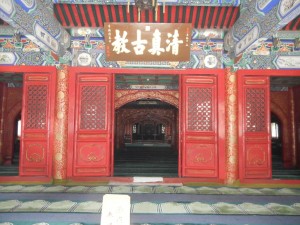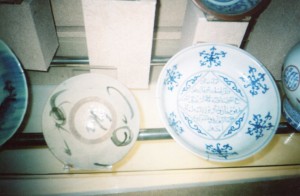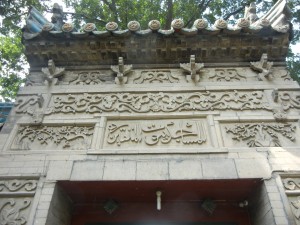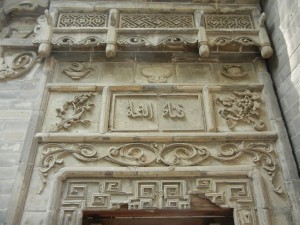The Message meets the Way.
Islam was introduced to China in the seventh century through ports of the southeastern coastal cities of Guangzhou and Quanzhou, and a little later over land through Central Asia, and into the Tang Dynasty’s capital in modern Xi’an. Nearly 1,500 years of cultural contact created one of the world’s most beautiful artistic fusions. I was amazed the first time I saw Chinese Islamic art.
My first time was in Malaysia.
The bowl on the right has Arabic calligraphy in the center, and it’s surrounded by motifs that were partially inspired by Chinese cloud patterns. Both traditions blended perfectly:
1. Chinese and Islamic thought emphasize the circle. There are differences though. Islamic ideas of the circle stress the creative power of God emanating from the center. Chinese ideas stress smooth circulation of energies throughout the circle, such as yin/yang flows. But both traditons see a circle as a dynamic flow of spiritual energy, rather than just an abstract shape.
2. Chinese art and Arabic script emphasize flow, rather than static lines and shapes. Arabic letters are conjoined, and they can thus wrap around the insides of bowls and mesh with yin/yang patterns. Chinese cloud motifs can surround Arabic letters, as in the above shot of a tombstone in Xi’an’s Great Mosque. Both are elegantly animated, and thus mix well. The clouds seem to represent the heavens that the departed soul aspired for. But they do so with ancient Chinese motifs. Traditional Chinese religions have emphasized ancestors, and many sculptures show ancestors and gods surrounded by clouds. In Islam, there is only God. Ancestor veneration is forbidden, but some of the same ancient designs expressed this person’s concept of God.
So there are endless ways that ideas and art forms from both cultures can fuse. While in Malaysia, I thought, “Wow! There’s an immense world here, and few people know about it!”
Islamic calligraphy and Chinese art forms are also happily married on this gate in Xi’an’s Great Mosque.
And over this doorway in the mosque.
And around the entrance to its prayer hall.
Xi’an was the main eastern terminus of the Silk Road during the Tang Dynasty, and it housed many traders who had ventured there on horses and camels from Central Asia. The Islamic Quarter around the Great Mosque still thrives, with lots of open-front shops that sell kabobs.
The above picture is from Beijing’s Cow Street Mosque. Here, and in the entrance in the top photo, Indian designs mix with Chinese and Islamic motifs. The glare comes from the window that I had to shoot through. Prayer halls and classrooms were closed to non-Muslims in the Beijing and Xi’an mosques. Prayer halls are usually open in the Middle East, India and Southeast Asia. Lots of police cars lined the streets of Xi’an’s Muslim Quarter. But though authorities in China are skittish about Islam, a great experience I had in Beijing’s mosque suggests that young educated people are curious about it. If young people’s horizons continue to open up, they’ll be rewarded with a magnificent artistic heritage that has flourished around the political tensions.








Comments on this entry are closed.